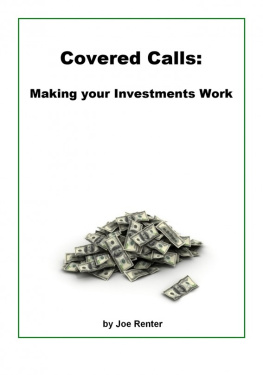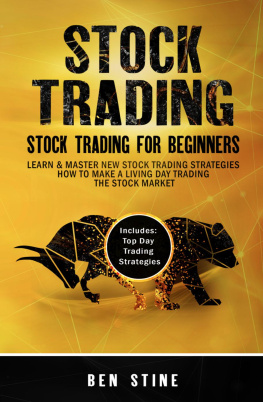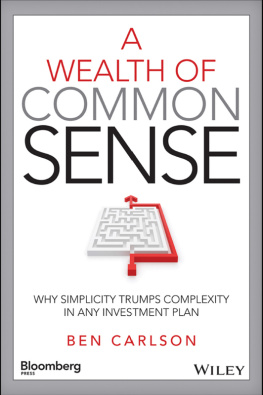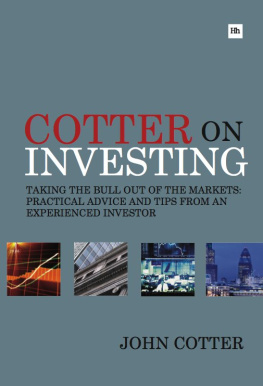Covered Calls:
Making your Investments Work
By Joseph Renter

Covered Calls:
Making your Investments Work
By Joe Renter
Smashwords Edition
Copyright 2014 Joe Renter
Smashwords Edition, License Notes
This e-book is licensed for your personal enjoymentonly. This e-book may not be re-sold or given away to other people.If you would like to share this book with another person, pleasepurchase an additional copy for each recipient. If youre readingthis book and did not purchase it, or it was not purchased for youruse only, then please return toSmashwords.com and purchase your owncopy. Thank you for respecting the hard work of this author.
ISBN: 9781310442698
Title:Covered Calls: Making your Investments Work
Author: Joe Renter
Publisher: Smashwords,Inc.
For Gunnar
You have already made me rich, now letsbecome wealthy.
INTRODUCTION
The first time I wrote a covered call, I wasnervous. I was afraid that Id mess something up. If youve beeninvesting for longer than a year, you know that a mistake can occureasily. You sell too early, buy too late, theres an investigationinto a company that drives its stock down. Then, as I watched theoption unfold over the period of 6 weeks, I thought: This islegal? And, indeed, it is.
A covered call is simply offering someone theoption to buy your stock, at a price that would bring you a profit.The seller really cant lose; if you offer the option, you shouldbe willing to sell the stock at the price offered. Sure, the stockprice may go much higher than the option price, but thats a chanceworth taking. No matter what happens, you keep the premiumearned.
Let me repeat that: no matter what happens, YOUKEEP THE PREMIUM.
If the stock price does not rise to the strikeprice, you still keep the premium that you were already paid. Youdont give it back. It was paid to you when you wrote the option.Its yours to keep.
The premium that you receive is like a goodfaith down payment. Another investor pays you an amount for thepossibility of buying your stock at a future time. Why would anyonedo that? They are betting that the stock price is going to go up.Way up. And by promising to buy your stock at a certain price, theyare hoping they are going to purchase your shares at a price lowerthan the market price. They dont have to have all the money topurchase 100 shares of stock immediately, but they can hold theopportunity to buy those 100 shares until theyre absolutely readyto pay for them.
There are two things that you must do before youstart profiting from covered calls. First, do your homework. And,honestly, the homework is simple. Read this e-book, perhaps do aninternet search on the term Covered Calls, visit the websitessuggested at the end of this book.
Second, youll need to talk to your brokerage,as they will need to grant you permission to write covered calls.This, typically, will involve you asking them to allow you to dothis, and perhaps a short questionnaire. Thats it. Thats allthere is. And if thats all it takes to get started on coveredcalls, it must be simple, right?
And now, on with the lesson!
What is a Call?
A call option, or call, is a contract betweentwo investors for a particular stock. The seller, or writer, of thecall option is offering their lot of a particular stock (a lot is100 shares) for a particular price. The buyer pays a premium forthe right to buy the stock, but they are not obligated to purchasethe stock.
Each contract is an option to purchase 100shares of stock. If you own 400 shares of XYZ Corp., you couldwrite up to four contracts, but you may choose to only write one ortwo contracts at any given time.
There are three main items to be aware of whenwriting a covered call:
Expiration or Call date this is the date thatthe option expires
Strike Price this is the price the stock maybe sold for
Premium this is the price by the buyer forthe option
The expiration date is typically the third weekof the following month, although it may vary depending on thestock. You can often choose a date farther out than the next month,if you wish. The options chain table will list the upcomingexpiration dates for a particular stock. (For more informationabout the options chain table, see the section The OptionsChain.)
The strike price may be in increments of $0.50,$1.00, $2.50, or another amount. The buyer agrees to a given pricethat the seller is hoping to earn from the stock. If the price ofXYZ is currently $33, you may choose to write your call at a strikeprice of $36. The options chain will have a list of the availablestrike prices. The strike price is determined by the volatility ofa stock; stocks that have larger price swings usually have biggerspreads in the strike price.
The premium is the price, per share, that thebuyer is willing to pay for the option. This is usually expressedon options chains as a bid and ask price. The seller of the optionmay ask for $0.35 per share, but the buyer may only be willing topay $0.30 per share. The premium, then, would be $30.00 = $0.30 x100 shares. The premium is paid as soon as a buyer purchases thecontract. Again, the options chain will list all the potentialpremiums for a particular stock.
There is one other important piece ofinformation to remember when dealing with options; your brokeragefee for writing the option. If your brokerage charges $7 per trade,on the above $30.00 premium, your net gain is $23.00 ($30.00 -$7.00 = $23.00). If the premium is $0.05, and your brokeragecharges $10, it wouldnt make sense to write a call: $5.00 - $10.00= -$5.00. Be aware of your fees before choosing a strike price. Thehigher the strike price, the lower the premium will be.
Writing a Covered Call
There are two types of call options: CoveredCalls and Uncovered or Naked Calls. Covered Calls are options topurchase 100 shares of a stock that you currently own. They arecovered, because you have the stock, and if the buyer of thecovered call option exercises his option, you will sell the stockto him. It is possible to write a call on un-owned stock, but thisinvolves more risk to the investor and will not be examined in thisbook*.
Covered calls are an excellent way to increaseyour return on an investment. Many stocks pay dividends, and manyinvestment advisors will tell you that you can increase your yieldby writing covered calls on stocks you own. This does not affectthe amount of dividends paid by a company, unless your call datehappens to fall before the ex-dividend date. However, you can earnadditional profit on your stock, by writing covered calls.












